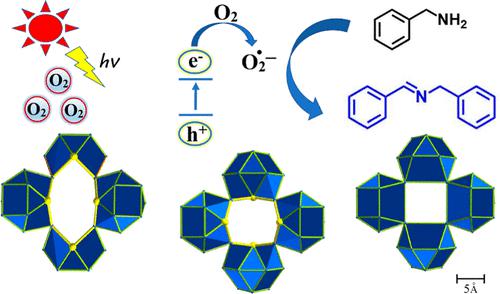当前位置:
X-MOL 学术
›
Inorg. Chem.
›
论文详情
Our official English website, www.x-mol.net, welcomes your feedback! (Note: you will need to create a separate account there.)
Controlled Assembly of Ru-Containing Polyoxometalates for Photocatalytic Activity of the Primary Amine Coupling Reaction
Inorganic Chemistry ( IF 4.6 ) Pub Date : 2022-06-16 , DOI: 10.1021/acs.inorgchem.2c00718 Huafeng Li 1 , Wenjing Chen 1 , Zelong Yuan 1 , Yuzhen Jin 1 , Yujie Zhao 1 , Pengtao Ma 1 , Jingyang Niu 1 , Jingping Wang 1
Inorganic Chemistry ( IF 4.6 ) Pub Date : 2022-06-16 , DOI: 10.1021/acs.inorgchem.2c00718 Huafeng Li 1 , Wenjing Chen 1 , Zelong Yuan 1 , Yuzhen Jin 1 , Yujie Zhao 1 , Pengtao Ma 1 , Jingyang Niu 1 , Jingping Wang 1
Affiliation

|
Three Ru-induced structural interconversion polyoxometalates (POMs), Na13H5[Ru4(H2O)2(Cl)2(WO2)4(AsW9O33)4]·43H2O (1), K5Na9H8[Ru2(WO2)4(AsW9O33)4]·50H2O (2), and KNa13H14[(WO2)4(AsW9O33)4]·34H2O (3), were successfully synthesized and thoroughly characterized. Interconversion of structures was accomplished by changing the number of active sites for compounds 1–3. All three compounds contain one {As4W40O140} unit, showing similar structural characteristics except for the active center number (Ru). Interestingly, compound 1 [turnover number (TON)= 486; turnover frequency (TOF)= 20 h–1] showed highly efficient photocatalysis in achieving oxidative coupling of primary amines. Compound 2 (TON = 406, TOF = 17 h–1) was also found to promote the oxidative coupling with relatively poor efficiency; however, compound 3 (TON = 178; TOF = 7.4 h–1) had no obvious contribution to the coupling reaction system, and a chain of evidence indicates that the catalytic performances are strongly dependent on element contents of active sites. Furthermore, the Ru-containing POM-based photocatalysts are conveniently recyclable and reusable during the photocatalytic processes. This study demonstrates the possibility of tuning the catalytic efficiency and stability of POM-based photocatalysts by well designing and controlling their structures. The possible reaction mechanism for the photocatalysis synthesis of imine product is also proposed based on experimental studies.
中文翻译:

含钌多金属氧酸盐的可控组装用于伯胺偶联反应的光催化活性
三种Ru诱导的结构互变多金属氧酸盐(POM),Na 13 H 5 [Ru 4 (H 2 O) 2 (Cl) 2 (WO 2 ) 4 (AsW 9 O 33 ) 4 ]·43H 2 O ( 1 ), K 5 Na 9 H 8 [Ru 2 (WO 2 ) 4 (AsW 9 O 33 ) 4 ]·50H 2 O ( 2 )、KNa 13 H 14[(WO 2 ) 4 (AsW 9 O 33 ) 4 ]·34H 2 O ( 3 )成功合成并进行了全面表征。通过改变化合物1-3的活性位点的数量来实现结构的相互转换。所有三种化合物都含有一个{As 4 W 40 O 140 }单元,除了活性中心数(Ru)外,显示出相似的结构特征。有趣的是,化合物1 [营业额数 (TON)= 486;周转频率 (TOF)= 20 h –1] 在实现伯胺的氧化偶联方面表现出高效的光催化作用。还发现化合物2 (TON = 406, TOF = 17 h –1 ) 促进了氧化偶联,但效率相对较低;然而,化合物3 (TON = 178; TOF = 7.4 h –1) 对偶联反应体系没有明显贡献,一系列证据表明催化性能强烈依赖于活性位点的元素含量。此外,含Ru的POM基光催化剂在光催化过程中可方便地回收和重复使用。本研究证明了通过良好设计和控制其结构来调整 POM 基光催化剂的催化效率和稳定性的可能性。还基于实验研究提出了光催化合成亚胺产物的可能反应机理。
更新日期:2022-06-16
中文翻译:

含钌多金属氧酸盐的可控组装用于伯胺偶联反应的光催化活性
三种Ru诱导的结构互变多金属氧酸盐(POM),Na 13 H 5 [Ru 4 (H 2 O) 2 (Cl) 2 (WO 2 ) 4 (AsW 9 O 33 ) 4 ]·43H 2 O ( 1 ), K 5 Na 9 H 8 [Ru 2 (WO 2 ) 4 (AsW 9 O 33 ) 4 ]·50H 2 O ( 2 )、KNa 13 H 14[(WO 2 ) 4 (AsW 9 O 33 ) 4 ]·34H 2 O ( 3 )成功合成并进行了全面表征。通过改变化合物1-3的活性位点的数量来实现结构的相互转换。所有三种化合物都含有一个{As 4 W 40 O 140 }单元,除了活性中心数(Ru)外,显示出相似的结构特征。有趣的是,化合物1 [营业额数 (TON)= 486;周转频率 (TOF)= 20 h –1] 在实现伯胺的氧化偶联方面表现出高效的光催化作用。还发现化合物2 (TON = 406, TOF = 17 h –1 ) 促进了氧化偶联,但效率相对较低;然而,化合物3 (TON = 178; TOF = 7.4 h –1) 对偶联反应体系没有明显贡献,一系列证据表明催化性能强烈依赖于活性位点的元素含量。此外,含Ru的POM基光催化剂在光催化过程中可方便地回收和重复使用。本研究证明了通过良好设计和控制其结构来调整 POM 基光催化剂的催化效率和稳定性的可能性。还基于实验研究提出了光催化合成亚胺产物的可能反应机理。



























 京公网安备 11010802027423号
京公网安备 11010802027423号